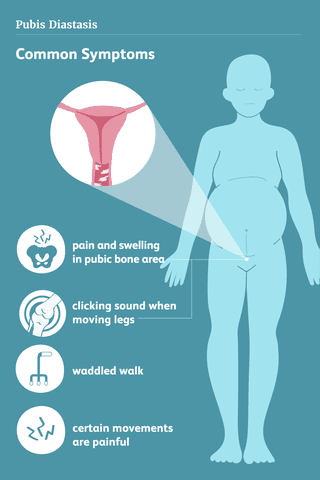Everything You Need to Know About Pubic Bone Pain During Pregnancy
Pubic bone pain during pregnancy may be normal, but it can disrupt your day-to-day life. Try these at-home treatments or talk to your doctor about medications.
Medically reviewed by Alyssa Dweck, MS, MD, FACOG
Many expectant parents will experience pubic bone pain during pregnancy. It is fairly common, particularly in later pregnancy—when the hormone relaxin causes the pelvis to loosen at the pubic bone. It is the bodies way of preparing for delivery. It makes birth easier for both parent and baby. However, sometimes this loosening is exaggerated, and this can be quite painful and persist into the early postpartum period.
The good news is there are things you can do to alleviate the discomfort. Here's everything you need to know about pubic bone pain during pregnancy, from what causes it to how to treat it.

Nusha Ashjaee
What Pubic Bone Pain During Pregnancy Feels Like
When there is too much laxity in a joint, there can be instability and pain. Most of the pain is centered upfront in the pubic bone area, above the mons pubis (below pubic hair), and it can feel like stabbing, wrenching pain.
Activities that can make pubic pain worse include:
getting out of bed
getting into the bathtub or car
putting on pants
sitting for long stretches
performing repetitive tasks
You may also note some swelling in the area of your pubic bone and experience waddling in the way you walk or notice that your legs don't quite come together. You may notice that you can feel or hear a clicking noise when walking or moving your legs. Your doctor or midwife can help you best understand your symptoms.
Causes of Pubic Bone Pain During Pregnancy and Risk Factors
The term for instability in the pelvic area is symphisis pubis dysfunction (SPD; also called symphisis pubis diastastis or pelvic girgle pain). It happens because of the way relaxin loosens joints and ligaments throughout the body. There's also increased pressure on the pelvis and pubic bone during pregnancy because of the weight of the uterus.
You may be more likely to experience pubic bone pain if:
this is not your first baby
you are carrying multiples
you have had previous pelvic trauma and/or a back injury
you are overweight
you have had SPD in a prior pregnancy
you are carrying a very large baby
In rare cases, the pubic bone may widen above the physiological norm, of 10 mm or greater. This can occur during pregnancy or the postpartum period. And it results in a total separation or instability of the symphysis without breaking the pubic bones.
How Pubic Bone Pain During Pregnancy Is Diagnosed
Because X-rays are not recommended during pregnancy, your practitioner may order an ultrasound or MRI. The ultrasound can look at the space between the bones of the pelvis. It is more common, however, to make a diagnosis based on your symptoms alone. If you have already had your baby and you are still having pain, an X-ray is the best diagnostic test available.
How to Relieve Pubic Bone Pain During Pregnancy
SPD is usually relieved once you have your baby. In the meantime, there are some treatments available to reduce discomfort during pregnancy.
Low back and pelvis support
Stabilize your pelvis as much as you can via a pregnancy/maternity binder, which can help to relieve back pain as well. You may also try using a rebozo Mexican shawl. Studies suggest that a flexible belt or binder works better than a rigid one. This can also help you prevent further injury from having a less stable pelvis.
Physical therapy and/or acupuncture
Ask your doctor or midwife about these treatments. They may help in the long term. While they may be time-intensive, many say it's worth it. Ask your therapist or acupuncturist for advice on what you can do at home in between visits.
Avoidance
Avoid situations that cause pain. For example, sit down to put pants on, or sit on the side of the tub and swing both legs over together.
Limit standing
It is also best to avoid standing for long periods of time. If you must stand, wear comfortable shoes and try to move around, even if this means you simply shift from foot to foot every so often. You can also use a small stool or box to prop one foot up as you stand.
Exercise
Certain forms of exercise can help reduce pain. Ask your doctor, midwife, or physical therapist for moves you can do. The buoyancy involved in swimming, for example, can provide pain relief.
Medication
Occasionally, pain medication is appropriate. However, this should be done under the supervision of a doctor, as some painkillers are not safe during pregnancy and breastfeeding, and some medicines should not be taken later in pregnancy.
Recovery
The good news is that shortly after delivery you should be feeling much better, as the production of relaxin stops. If you do not feel notably better after a few weeks, ask your practitioner for additional screening. You may need to add additional therapies, like physical therapy, to help build muscle strength in the pubic bone area.
Pubic bone pain during pregnancy can be quite uncomfortable and make basic tasks feel more difficult. A healthcare provider can help you make a plan to minimize pain. Most of the time this will involve lifestyle adjustments and waiting until the baby is born. However, there are some treatments that can help lessen pelvic discomfort.
For more Parents news, make sure to sign up for our newsletter!
Read the original article on Parents.
